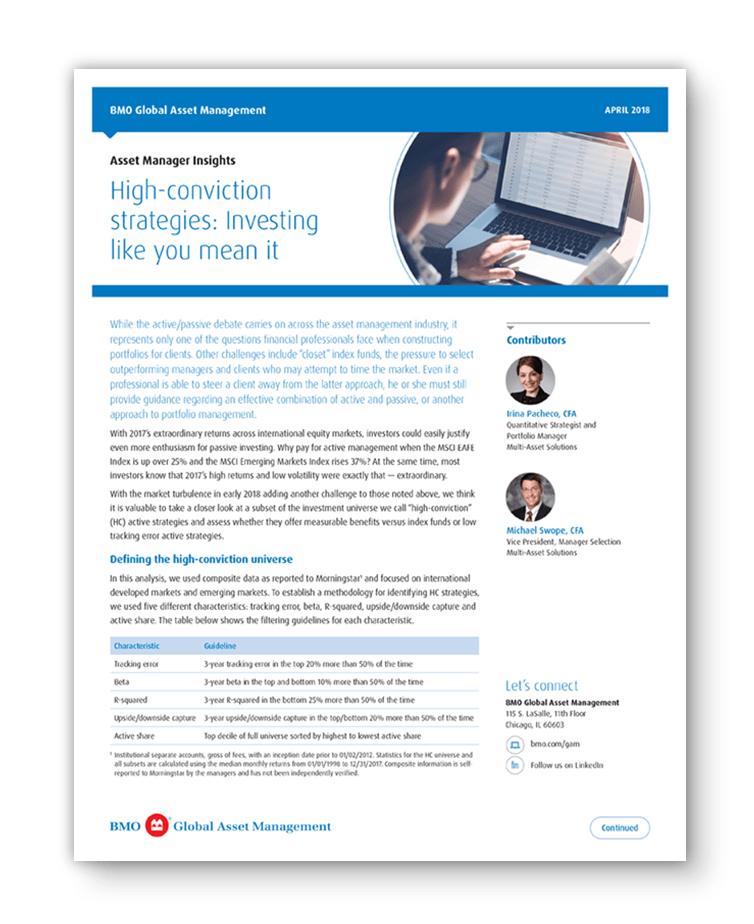
How do you justify investing in an active, high-conviction strategy when a lower-cost ETF or index-tracking fund offers comparable returns? Let the data drive better conversations and better outcomes.
We looked at the universe of investment strategies in developed international and emerging market equities and in examining the risk and return characteristics, found that high-conviction strategies can offer more than you may think.
HERE’S WHAT WE FOUNDThe Return To Normal
2017: Not the norm
With 2017’s extraordinary returns across international equity markets, investors could easily justify even more enthusiasm for passive investing. But indexers beware; the unusually favorable environment in 2017 is not the norm.
Extraordinary returns and low volatility
Return percentages in 2017
The return to normal
As investors and portfolios readjust to normal levels of risk and return, we think it is valuable to take a closer look at the subset of the investment universe we call “high-conviction” strategies.
Defining high-conviction:
Analysts utilize a range of data and criteria to identify strategies that diverge from broad market benchmarks.
CRITERIA
How to identify high-conviction
In our analysis, we used composite data as reported to Morningstar1 and focused on international developed markets and emerging markets.
Characteristics to define the high-conviction universe:
Tracking error
3-year tracking error in the top 20% more than 50% of the time.
The difference between the performance of a strategy and its benchmark.
Beta
3-year beta in the top and bottom 10% more than 50% of the time
A measure of a strategy’s volatility in relation to the market or a benchmark.
R-squared
3-year R-squared in the bottom 25% more than 50% of the time
A measure of a strategy’s movements that can be explained by movements in a benchmark index.
Up/down capture
3-year upside/downside capture in the top/bottom 20% more than 50% of the time
Evaluates strategy performance against the benchmark in periods when the benchmark return is positive/negative. A 100% ratio shows strategy performance in line with the benchmark.
Active share
Top decile of full universe sorted by highest to lowest active share
A measure of the percentage of stock holdings in a manager’s portfolio that differs from the benchmark index.
Universe
To establish the high-conviction universe, we included composites that appeared in three out of the five groups created by these filtering guidelines.
International developed markets
22/141 strategies qualified as high-conviction
Emerging markets
26/132 strategies qualified as high-conviction
OBSERVATIONS
Risk/return observations
The subset of high-conviction strategies that met our criteria returned both higher returns and lower risk (standard deviation) when compared to the full universe. See how the high-conviction strategies compared to other subsets.
For more high-conviction comparisons, download the full report.
Toggle the tags below to display comparisons on the chart.
Downside risk mitigation
Patience pays off for high-conviction investors.
For those investors with a long-term investment perspective, the story becomes more clear.
How often are high-conviction strategies top-quartile performers?
How do high-conviction strategies respond after underperformance?
Three years after delivering bottom-quartile performance, the probability of delivering top-quartile performance:
How do high-conviction strategies respond after outperformance?
Three years after delivering top-quartile performance, the probability of delivering bottom-quartile performance:
“There’s a lot of emotion that goes into investments, but to have this analysis could allow you to have a tool to show your clients that long-term patience is a virtue.”
Michael Swope, co-author of the report
Listen to the full interview
Improving performance is defined as delivering top-quartile performance three years after delivering bottom-quartile performance; declining performance is defined as delivering bottom-quartile performance three years after delivering top-quartile performance. Past performance is not a guarantee of future results.
PORTFOLIO
Add value in portfolio construction
For clients able to understand and accept some variation in short-term performance, high-conviction strategies offer the opportunity to improve their portfolio. In the full report, we provide a practical application of high-conviction strategies to a portfolio, showing the risk/return benefits of a 50% EFT/50% HC portfolio:

EXPLORE
Download the full research report
Explore our complete analysis of high-conviction managers by downloading the full report. You’ll get:
• Practical application - results from a sample portfolio • More and deeper comparisons of high-conviction vs. non-high-conviction • Additional client talking points

Fill out the form below to download the full report.
